|
The Pound
Knockholt
01959 532102
https://3shoesknockholt.co.uk/
https://whatpub.com/three-horseshoes
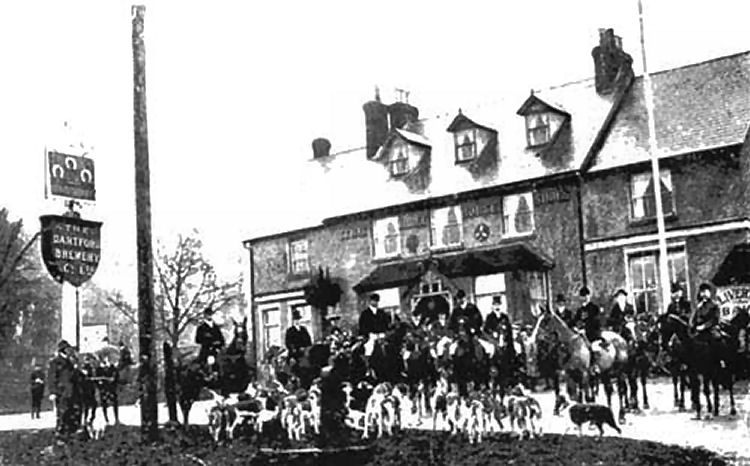
Above photo 1900. |
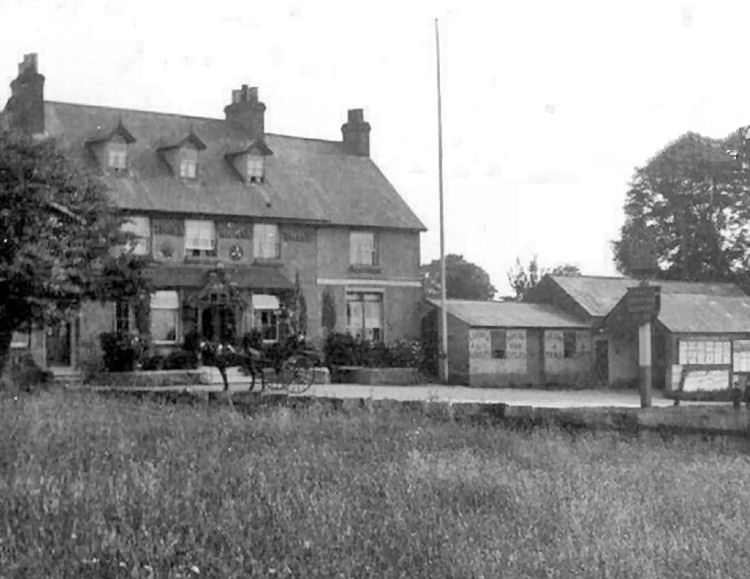 Above postcard, 1905. Kindly sent by Rory Kehoe. |
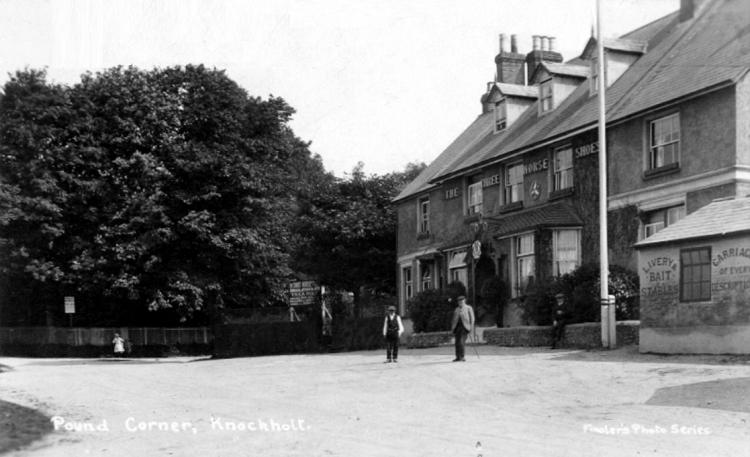
Above postcard, circa 1914, kindly sent by Rory Kehoe. |
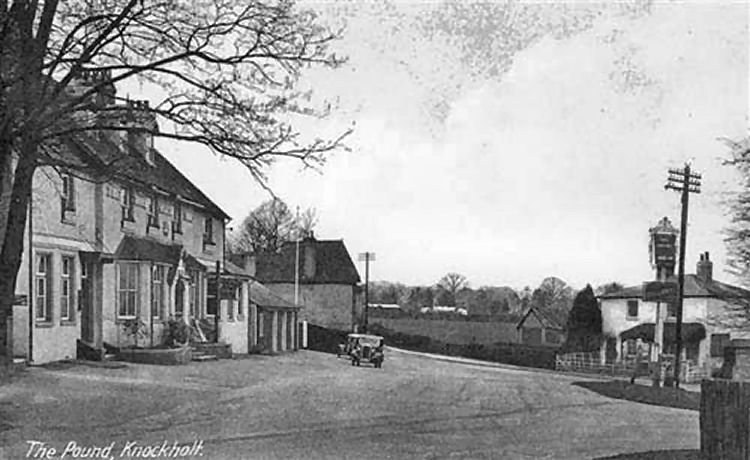
Above postcard 1931. |
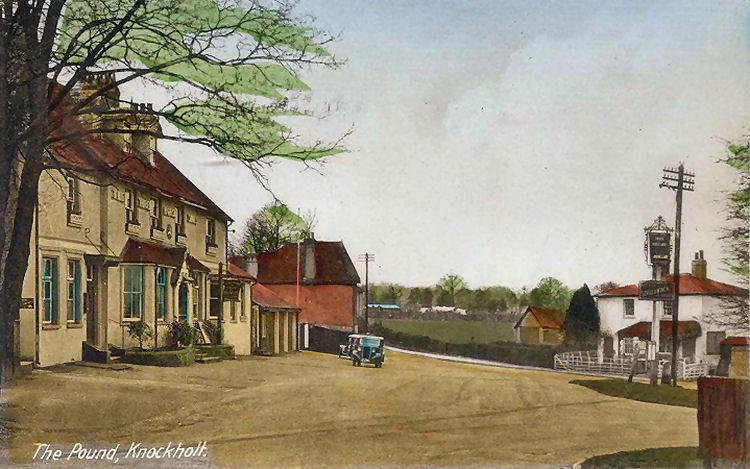
Above postcard the same as above but tinted. Kindly sent by Rory Kehoe. |
|
From Barclay, Perkin's Anchor Magazine. Vol. XV, No.6 - June 1935.
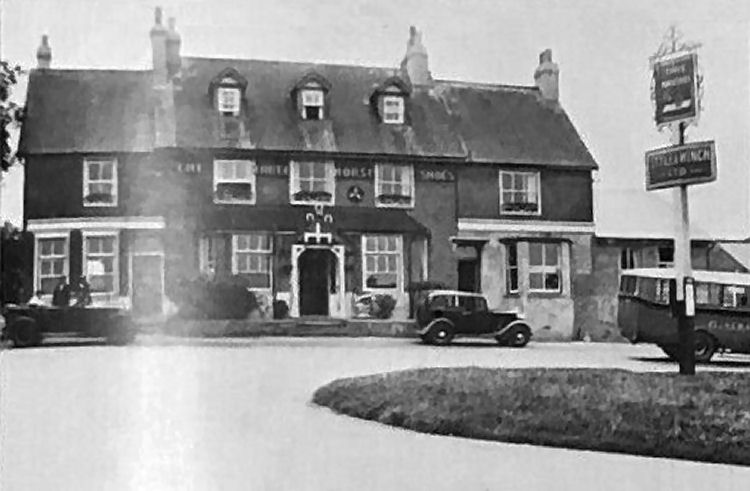
This house, in the countryside and yet so easy of access from town, offers every facility for
catering for parties and is a well-known house of call.
Recently the inside has been modernised and refurnished and the gardens
laid out attractively, as shewn in the photograph.
The popular tenant of the "Three Horseshoes," which belongs to the
Dartford Brewery Company,
is Mr. F. MacDonald.
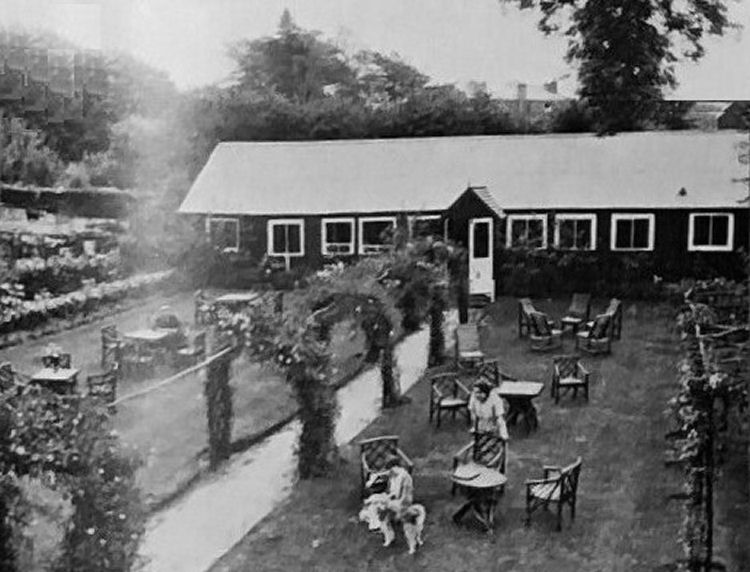
Kindly sent by Rory Kehoe. |
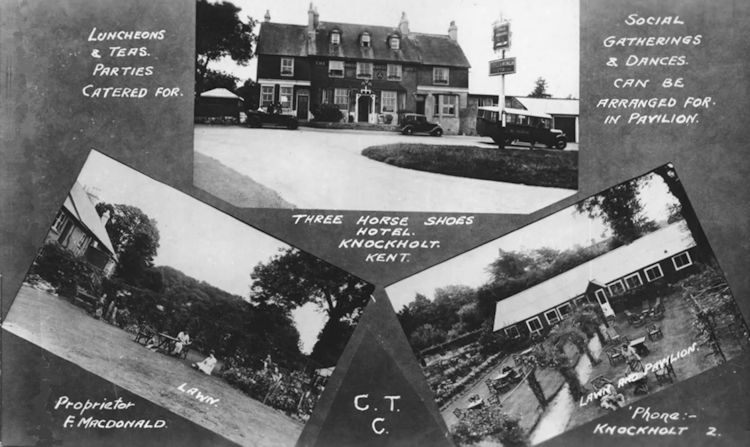
Above postcard, 1937. Kindly sent by Rory Kehoe. |
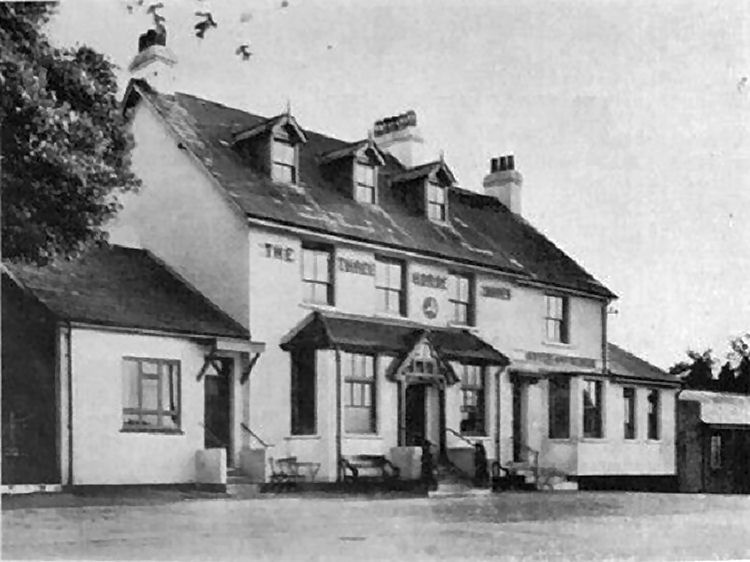
Above photo circa 1955, kindly sent by Rory Kehoe. |
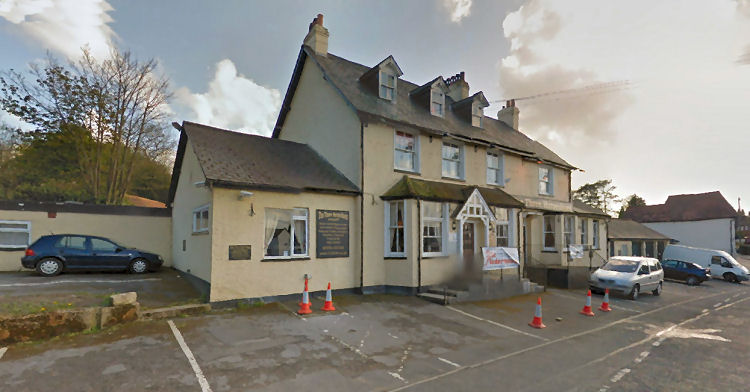
Above image from Google, April 2012. |
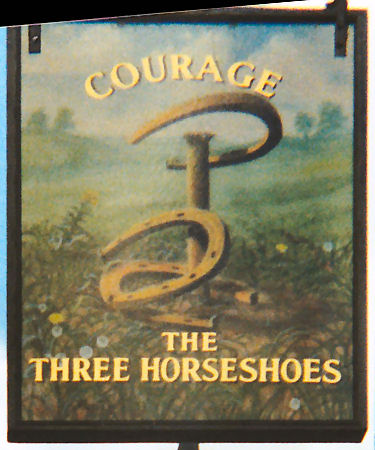
Above sign, March 1987.
With thanks from Brian Curtis
www.innsignsociety.com. |
 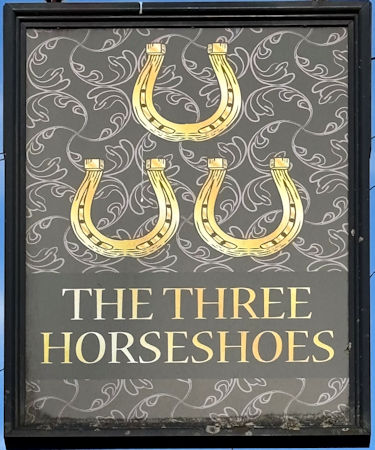
Above signs, 2025, sent by John Matthews. |
|
Information taken from
http://www.threehorseshoesknockholt.co.uk/
THE HISTORY OF THE THREE HORSESHOES
The "Three Horseshoes" is believed to date back as far as 1753. It
was then known as the "Horseshoes" and was a coaching inn as the road to
Chevening was the road to Rye. Local persuasion has it that the entrance
step is the same height above sea level as the top of the dome of St
Paul's cathedral.
Legend has it that William the Conqueror watered his horse at a dew
pond where the Knockholt beeches now stand - the highest point in the
highest village in Kent. Knockholt used to be a busy commercial centre
with farmers, fruit growers, shopkeepers, builders, blacksmiths,
butcher, bakers etc. There was still a blacksmiths in the village in
1915 with the forge next to the "Three Horseshoes." By 1938 commercial
life had declined with only a few trades remaining.
During the war years Ivy Farm, situated behind the "Three Horseshoes"
was used as an outstation of Bletchley Park functioning as an intercept
or relay station for radio signals. This work was concerned with Ultra,
the breaking of the German cipher said to have been the single most
significant achievement to have influenced the outcome of the war. It
was so secret that the village and those that work at Ivy Farm
themselves had little idea of what was going on.
The gates to Ivy Farm were guarded by military police, and the area
surrounded by barrage balloons, which gave a feeling of security during
the V1 raids. Workers often had lunch at the "Three Horseshoes" but
wartime food was very basic.
The station is 3.0 miles north-northeast of the village of Knockholt
but closer to several other settlements. The station serves several
small communities in the Sevenoaks district in addition to Knockholt.
Many people often wonder why the station is not named after the village
within it sits. To avoid confusion with Halstead in Essex and due to
Badgers Mount not entirely fulfilling the criteria for being a village,
it was named after the next closest village, which is of course
Knockholt.
E. S. Nesbit, resident in Halstead, set her famous novel "The Railway
Children" in and around the station.
More history of Knockholt and the "Three Horseshoes" can be found
here from the book - The History of Knockholt in the county of Kent by
David Waldron Smithers.
www.knockholtparish.org.uk
The name "Three Horseshoes" is the heraldic symbol of the Worshipful
Company of Farriers a Fellowship since 1356, chartered in 1674. The
assumption is that the design employed only three shoes as the other one
was being worked on or replaced by the farrier. Pubs bearing this name
were probably owned by the company or by its members.
Some signs, however show horseshoes gathered around a stake in the
ground, representing the horseshoe-throwing game which was popular at
the time.
Horseshoes have been used as pub signs for centuries. With a largely
illiterate population visual signs were an important means of attracting
customers and in 1393 Richard II issued an edict requiring all who
brewed and sold ale to display a sign to enable the ale conner (tester -
Shakespeare's father was one) to locate the premises.
A horseshoe sign was a popular choice because it was an easily
recognisable symbol and had the added reputation of being able to combat
witchcraft. It was also associated with good luck, a superstition to
which Lord Nelson, himself widely featured on pub signs, subscribed.
In addition to the "Horseshoes" and "Three Horseshoes," there are
pubs named "Four Horseshoes," "Five Horseshoes" and "Nine Horseshoes."
In 1753 the Landlady of the "Three Horseshoes" in Knockholt was Ann
Lambert, there has been 35 Landlords/Landlady's since then. Today it is
run by Sheena Welch who has been here since 2001.
Landlords/Landladies: |
The pub was a tied house within the estate of the Dartford Brewery
Company, which was acquired by Style & Winch's Maidstone brewery in 1924.
Although the brewery in Dartford was closed in 1926, Dartford Brewery
Company pubs remained in their original livery, even after Style & Winch was
snapped up by Barclay, Perkins' Southwark brewery in 1929.
Unfortunately the dates for most of the following licensees are as yet
unknown, but I believe they are in the correct order.
The census of 1861 addressed this as in Halstead.
|
From the Maidstone Telegraph, Rochester and Chatham Gazette, 28 September 1861.
Knockholt.
A friendly game of cricket was played at Knockholt on Wednesday, the
party afterwards partook of an excellent supper at the "Three Horseshoes
Inn."
|
|
From the Southeastern Gazette, 20 March 1866.
BROMLEY. County Court.
This court was held at the “White Hart” Assembly Room on Tuesday, before
J. ’Espinasse, Esq
English v. Ralfe.
The plaintiff is the landlord of the “Three Horse Shoes Inn,” Knockholt,
and he sought to recover £20 5s. 2d. being the balance of a large amount
of money he had lent the defendant at Knockholt, to assist him in his
business of butcher.
There were two or three other small items in the account, but the
defendant said he did not owe it all, only £18 or so.
His Honour, seeing one item “goose and gin,” said that the latter could
be not recovered, and he suggested that the accounts should be looked
through by some person on whom they could both agree.
The defendant wanted to know what “et cetera” was, but he consented to
the reference, and Mr. Bowen was named.
|
|
Sevenoaks Chronicle and Kentish Advertiser, Friday 6 September 1889.
County News.
At the Bromley Police Court on Monday, Henry Sheppard, who refused his
address, was charged with stealing a watch, value £4, from the person of
George Wells, at Knockholt.
As we reported last week, the case has been remanded from the Sevenoaks
Police Court.
The prisoner was with a party of excursionists, and met the prosecutor
at the "Three Horseshoes," Knockholt. On coming out of the house the
prosecutors alleged that he was assaulted by a number of the prisoners
companions, who knocked him down, when his watch was stolen. The party
drove away, but were followed by Constable Simmonds, who caught up with
them. A struggle ensued, but the prisoner was detained and the watch
found. The officer, who was injured, was obliged to use his truncheon.
The prisoner pleaded that he had nothing to do with the assault, and
simply picked up the watch on Knockholt green.
The Bench sentence him to 3 months' hard labour.
|
|
Maidstone Journal and Kentish Advertiser, Tuesday 13 May 1890.
Knockholt. The transfer of the Horseshoes.
Mr. R. Bennett applied to the magistrates at Bromley, on Monday, for the
licence of the "Horseshoe" to be transferred to him from Mr. Wood.
Superintendent Waghorn who was present in court, said that it was a
difficult house to conduct in consequence of the noisy parties that
occasionally visited there, but in the past Mr. Wood had taken every
precaution, and he only hoped that the ingoing tenant would do the same.
He must warn him that it was a very rough house.
In reply to the Chairman Mr. Bennett said that had kept a house before.
The Chairman said the Bench would rant the transfer, but they warned him
of what he would have to contend with as he had been in the same
business before, he should be aware how his business should be
conducted. He would always find that the Bench would protect him; that
was to say; not against any infringements of the law, but if he required
protection from the public.
|
|
Bromley & District Times, Friday 25 May 1894.
Funeral of Mr Bennett.
The funeral took place at Chatham Cemetery, on Friday afternoon, of the
late Mr. James Bennett, for several years landlord of the "Three
Horseshoes" at Knockholt, and whose death was recorded last week. The
interment was witnessed by a large number of friends, the deceased's
family being well known in the neighbourhood of Chatham, whilst a lovely
wreath of flowers was sent as a mark of respect, from the Old Brompton
Masonic Lodge, of which Mr. Bennet had for years been a member. He was
also a member of the Cray Valley Lodge (St Mary's Cray,) and was well
known in his immediate locality. The deceased was 41 years of age.
|
|
From the Anchor, (house magazine for Barclay, Perkins Anchor Brewery
Volume XXXV, No.1, January 1955.
Three Horseshoes, Knockholt.
This house, following extensive alterations and redecorations, is now in
full swing again under the able tenancy of
Mr and Mrs Summers, who have recently come from the "Rising Sun" at
Leatherhead.
Mr and Mrs Summers have been tenants of Messrs. Barclay, Perkins for many
years in the New Cross area and are
known to wide circle of friends and customers.
The "Three Horseshoes" (Dartford Brewery) standing as it does at the
junction of five roads, has long been a source
of attraction to visitors, from not only the immediate surroundings but
from London and it was a favourite spot for
outings in the old four-in-hands. The visitors, after walking through
the lovely lanes and after viewing the famous
Knockholt Beeches, would end their day in the bars and attractive
gardens of the "Three Horseshoes."
A further point of interest, which has recently come to light in the
grounds of a house adjacent to the "Three Horseshoes"
is the summer house owned by Mrs Thrale and used extensively by Dr
Johnson (the lexicographer.)
The "Three Horseshoes" stands on the second highest point in Kent and
glorious views of the surrounding countryside
can be obtained in the very near vicinity.
By Rory Kehoe:- Hester Thrale was the widow of Henley Thrale MP who owned the Anchor
Brewery and who died in 1781. Henry Thrale
was a close friend of Dr Samuel Johnson. A few months after Henry's
death, Hester sold the Anchor Brewery (for the huge
sum of £135,000 - about £23 million in 2020) to David Barclay (of the
banking family) and John Perkins, the brewery manager.
Perhaps as a gesture of literary respect, Barclay, Perkins' trademark
was the portly image of Dr Samuel Johnson.
|
|
From the
https://www.bbc.co.uk By Joshua Askew, 15 February 2025.
Woman killed in Valentine's Day pub shooting.
A woman in her 40s has died in a Valentine's Day shooting outside a
village pub in Kent as a manhunt continues.
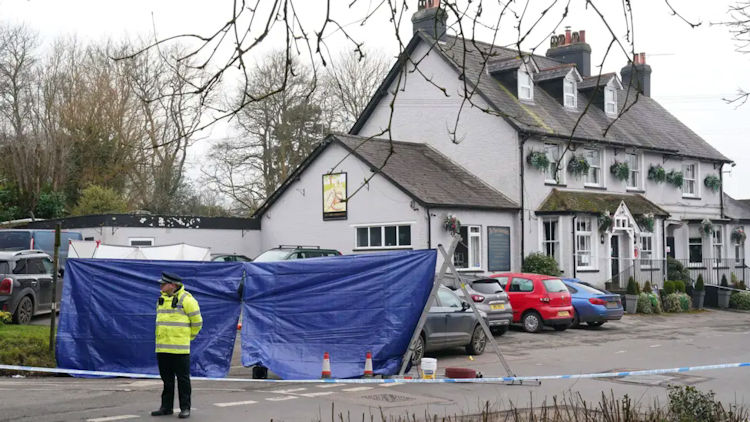
A police officer stands outside the Three Horseshoes pub in
Knockholt.
One local resident reported hearing "bangs" and a woman "shouting"
Kent Police said it was treating the shooting at the Three Horseshoes on
Main Road, Knockholt, just after 19:00 GMT on Friday, as a murder
inquiry.
The woman, who had gunshot wounds, died at the scene, officers said.
A vehicle recovered at the Dartford Crossing along with a firearm is
being linked to the death, police have said.
The suspect, a man who is believed to be known to the victim, left the
area and is currently outstanding.
Kent Police said it was working to identify and locate "all persons
potentially involved".
Local resident Chris Warner told the BBC: "It's a really quiet area.
Everybody knows everyone.
"It's just so shocking that something like this could happen here."
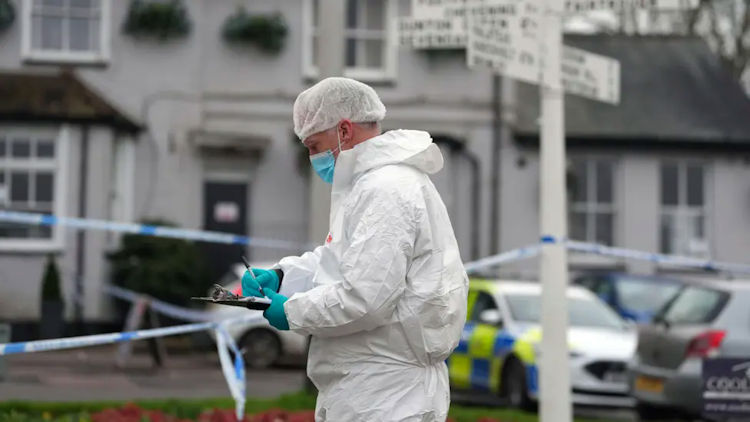
A police forensic officer writes on a clipboard, wearing a white gown
and blue plastic gloves.
In a statement posted on its Facebook page, the Three Horseshoes pub
expressed its "sincere condolences to the victim's family and friends".
It added: "We also want to send our support to anyone else in the local
and surrounding community who have been impacted by this.
"Please be respectful of everyone involved at this difficult time."
Steve Maines, a parish councillor in Knockholt, told the BBC he heard a
"commotion" outside the venue and was told someone had been shot.
He said: "We were sitting having our Valentine's Day meal when all of a
sudden we heard this huge commotion outside in the car park.
"We were told someone had been shot so we had to leave."
Villager Dorothy Wong said: "I heard around three to four bangs outside
and loud shouting from a woman's voice."

Two police vehicles are parked outside a white pub.
Police officers cordoned off the area on Saturday.
Ray Picot has lived in the village for 30 years.
He said: "We looked out and saw the whole area cordoned off with
ambulances, police and flashing lights.
A separate notice on the pub's Facebook page said it would be closed on
Saturday "following a tragic incident outside the pub last night".
The Three Horseshoes is located about five miles (8km) north-west of
Sevenoaks.
BBC reporter Daniel MacLaren said on Saturday morning the area
immediately around the pub was cordoned off with police tape.
Police officers were standing by at the scene to prevent access.
|
|
From the
https://www.kentonline.co.uk By Alan Smith, 17 August 2025.
Outrage at plans to pull down The Three Horseshoes in Knockholt.
Plans to demolish a working village pub for housing have unleashed
strong feelings, with more than 70 people objecting to the “outrageous”
scheme.
The owners of the Three Horseshoes at Knockholt Pound near Sevenoaks
have applied for permission to demolish the pub and to replace it with a
terrace of seven homes.
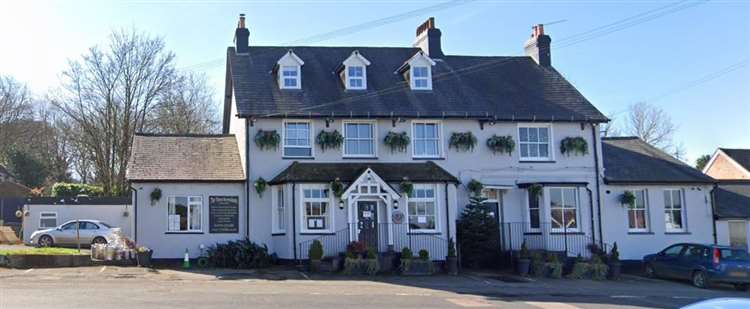
Are the days numbered for The Three Horseshoes at Knockholt?
The pub’s owners, Gareth and Michelle Thomas, say they have been trying
to sell the Horseshoes for the past 14 months but there have been no
takers.
Some villagers suggest that’s because their asking price of £999,995 is
too high, and the business is only valued at £750,000 in the viability
statement submitted in support of the application.
However, the owners say while the pub has continued to attract a
“reasonable level” of custom throughout the summer months, largely due
to the attractiveness of the garden area and outdoor events, viability
throughout the remaining months of the year remains “challenging”
In a supporting statement they add: “The Three Horseshoes, in line with
many other pubs and hospitality venues, has struggled to remain viable
since Covid and also because of the cost of living crisis.
The boozer stands on the site of an historic coaching inn on the route
from London to Rye, but the present Victorian building only dates from
1880 and has been subject to several alterations and extensions since
then. It is not listed.
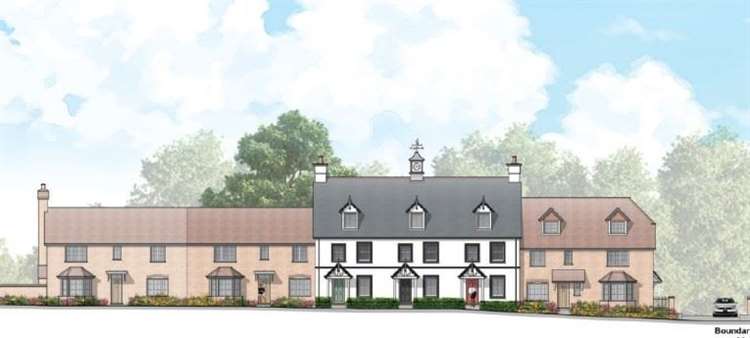
An artist's impression of how the new homes will look on the site of The
Three Horseshoes at Knockholt. Image OSP Architecture.
The proposal is for a row of seven non-identical terraced homes.
These would be one pair of four-bedroom, two-and-a-half-storey homes,
and then a row of three larger “landmark” properties, which would
include a central clock tower.
They would also be two-and-a-half storeys and with four bedrooms.
Finally, there would be a pair of subordinate two-storey, three-bedroom
homes.
Each would have a small front garden, while sixteen parking places would
be created in a rear car park, two for each property, plus two visitor
spaces.
The applicants say this would represent a safety improvement over the
existing situation. There is currently some parking in front of the pub,
but that requires patrons to reverse into the main road when leaving.
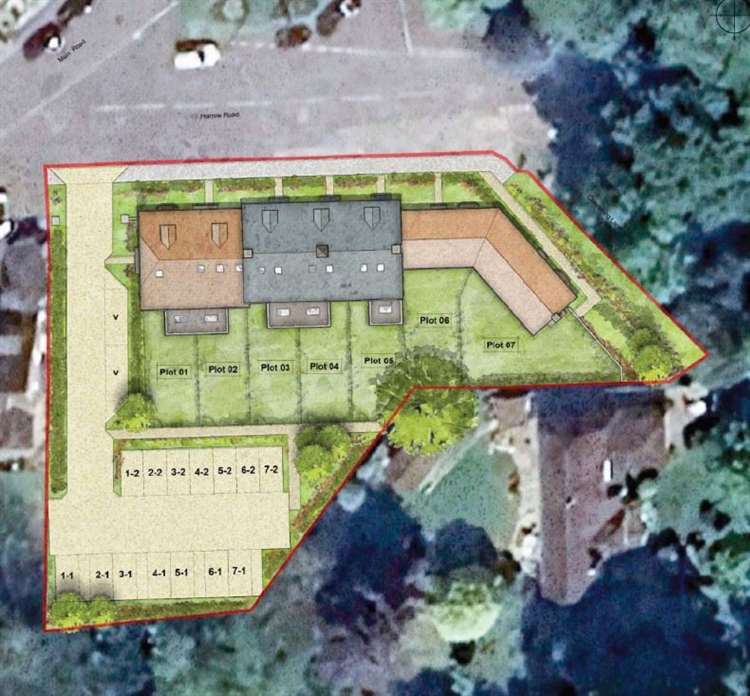
The proposed layout of the new homes at The Three Horseshoes at
Knockholt. Image OSP Architecture.
The agents say: “The applicants have been in the leisure trade for many
years and wish to start a new chapter in their lives.
“The existing public house has become more challenging in recent years
to run viably, particularly in the winter months and therefore
alternative options are being considered.
“However, it must be stressed that the business continues to be viable
as a public house and restaurant and the applicant would expect a
reasonable return were they to sell it in its existing form, which is
why it is currently marketed with an asking price of £999,995.
The agents argue that the pub owners did look at keeping the existing
building and converting it to flats, but they commissioned a viability
study that suggested that would not be economically viable.
Demolition and replacement with the terraced homes, on the other hand,
could produce an additional £1million profit over the estimated value of
the current building.
Among the many letters of objection, one said: “This is outrageous -
this is a thriving pub in the middle of a wonderful village which should
be protected as an asset of community value, not knocked down to build
overly expensive new builds which will be sold off to commuters and
unaffordable to the local community.
“The Three Horseshoes is not only a valued community asset but also a
vital part of the village's social and historical fabric.”
Another said: “It appears to be a profitable business, which is obvious
for all to see.
“It employs local people and is considered a hub for the Knockholt
community.
“The pub has been advertised for sale with an asking price of £1m. The
financial viability statement highlights that the current owners are not
willing to accept a lower offer, but by keeping the asking price
significantly higher than a realistic market value, it's no surprise
offers haven't been forthcoming.”
Another “dismayed” commenter added the pub had been “in the heart of the
village for decades” and it was “obviously a popular pub as the car park
is often full”.
“Residents use The Shoes for all sorts of special occasions, including
funeral wakes. It's a real social hub and would be sorely missed,” they
added.
“If we lose The Shoes, there will be only one pub, The Harrow, to serve
both Knockholt and Halstead.”
However, not everyone was opposed to the plan.
One resident said: “I visited a number of times recently to find there
was hardly anyone in there.
“It is a very sad to see that people are not going to public houses
anymore.
“As we are in need of housing, it would be a much better use of the land
to convert it into housing rather than becoming an empty shell.”
Another added: “There is a housing crisis so adding much needed local
housing on brownfield sites is essential. Many schools are still
undersubscribed so there is capacity.
“Furthermore, far from being a community asset, the current use is a
magnet for antisocial behaviour, so removing it would enhance village
life.”
The pub made the national headlines this year after it became the scene
of a fatal shooting on Valentine’s Day when Lisa Smith, 43, who had been
drinking inside, was shot dead in the car park.
Police said they believed that her husband, Edward Smith, also known as
Edvard Stockings, was her killer, but he was believed to have died after
going into the River Thames after the 43-year-old’s car was found
abandoned on the Queen Elizabeth II Bridge at Dartford.
Instead it conceded that if it were to “reluctantly” accept the loss of
a central village pub and loss of employment, it would agree the
application presents a “potentially sympathetic design”.
|
|
From the
https://britanniadaily.co.uk Wednesday, September 17, 2025. By Tara Whitman.
Woman Shot Dead by Husband Outside Kent Pub After Fleeing Marriage on
Valentine’s Day, Inquest Rules.

A woman was shot and killed by her husband outside a pub on Valentine’s
Day after trying to leave the relationship, an inquest has concluded.
Lisa Smith, 43, was shot twice in the neck in the car park of the "Three
Horseshoes" in Knockholt, Kent, after her estranged husband tracked her
down and opened fire with an illegally-held handgun.
Area Coroner Katrina Hepburn ruled on Wednesday that Ms Smith died from
unlawful killing, finding “requisite intent from Edward Smith to kill
her or cause her really serious harm.” The court heard how Mr Smith
fired four shots at his wife before sending voice notes confessing to
the murder and then jumping to his death from the Queen Elizabeth II
Bridge.
Ms Smith, from Slough, had told her sister earlier on 14 February that
she was leaving her husband and had boarded a train to Kent to stay with
family. Her husband tracked her down at the rural pub that evening,
blocking her friend’s car with his vehicle before opening fire at close
range.
Detective Sergeant James Dolby told Kent and Medway Coroner’s Court that
Ms Smith was picked up at Orpington station at approximately 2:40pm by
her sister Samantha Graham and a group of friends. The group initially
went to The Three Horseshoes pub before leaving and returning at around
6pm.
Just before 7pm, Ms Smith was sitting in the passenger seat of her
friend Nancy’s Seat car in the pub car park when her husband arrived. He
had been calling Ms Smith and her friends repeatedly whilst searching
for her throughout the afternoon.
A “verbal altercation” erupted between Mr Smith and his wife’s sister
Laura inside the pub, during which she called him a “narcissist”. He
initially left the scene but returned moments later to carry out the
fatal attack.
DS Dolby told the court: “At 18:59 Nancy reverses her Seat onto Harrow
Road and stops to speak with Laura. Edward manoeuvres his vehicle to
stop Nancy from exiting. Effectively Edward has blocked them in.”
Four Shots Fired at Close Range.
The coroner detailed the horrifying sequence of events that followed. Mr
Smith fired the first two shots from inside his own vehicle towards the
Seat car containing his wife. Neither of these initial shots caused
injury.
Ms Hepburn stated: “He pulled forward in the car and fired a second
shot, he was seen to exit the vehicle with arms outstretched holding a
handgun and firing a shot through the driver’s side car window.”
This third shot caused “fatal damage” to Ms Smith’s neck. Mr Smith then
walked around to the passenger side of the vehicle and fired a fourth
shot at his wife from close range.
“Four shots were fired, the first two from within his vehicle towards
the Seat. There were no injuries consistent with the trajectory of those
first two bullets,” the coroner confirmed.
Father Questions Why They Didn’t Drive Away.
During Wednesday morning’s proceedings, Ms Smith’s father asked the
detective why the occupants hadn’t driven away after the first two shots
were fired. “You’d have started up and gone, wouldn’t you?” he asked the
court.
DS Dolby explained that the attack “happened very quickly”, leaving no
time for escape. The entire shooting sequence occurred within moments,
with Mr Smith’s vehicle deliberately positioned to prevent any exit.
Despite immediate CPR performed by members of the public and emergency
services, including an off-duty firefighter who was inside the pub, Ms
Smith was pronounced dead at 7:42pm. The court heard she suffered two
gunshot wounds to the neck and one to the chest.
Voice Notes Confession Before Suicide.
Following the murder, Mr Smith sent voice notes to someone he referred
to as “Nana”, confessing: “I’ve shot Lisa, she’s dead.” In one of the
messages, he alluded to suicide and stated: “Hopefully I’m going to get
into heaven with my wife.”
The court also heard that Mr Smith called his long-time friend Leslie
Thompson less than two hours after the shooting. During the 8:50pm call,
he reportedly said: “She’s dead, I love you. I’ll see you on the other
side.”
Mr Thompson, who had known the couple for more than 30 years, believed
his friend was having a breakdown. He told investigators that Mr Smith
had said: “I can’t live, we’ve all gone together” whilst also stating
that “armed police will probably shoot me.
Mental Health Struggles Revealed.
A separate inquest into Mr Smith’s death, held the same afternoon by
Deputy Coroner Alan Blunsdon, revealed he had been experiencing mental
health difficulties. The court heard evidence from his GP at Burnham
Health Centre, who confirmed Mr Smith had attended an appointment for
mental health problems.
The 43-year-old told his doctor he had been sectioned approximately 10
years earlier and had previously experienced psychosis, though his
mental health had been stable since. The GP noted that Mr Smith “had
been arguing with his wife” and that Ms Smith had previously left him at
Christmas as she was “unable to cope any more” but had returned to the
relationship.
Mr Smith was prescribed medication and directed to seek further mental
health support. In a follow-up appointment in January, he told his GP he
was “feeling better”. He had no further contact with the surgery before
the tragedy.
Body Found in River Thames.
After shooting his wife, Mr Smith drove to the Queen Elizabeth II Bridge
at Dartford, where his car was found abandoned just before midnight on
Valentine’s Day. Police recovered the vehicle along with the illegal
firearm used in the murder.
Officers received reports of a man on the wrong side of the bridge
barrier, and Mr Smith was seen jumping from the bridge. His body was
recovered from the River Thames on 7 March near Coldharbour Lane,
Rainham, Essex, after being spotted by a member of the public using
binoculars.
Deputy Coroner Alan Blunsdon concluded that Mr Smith died by suicide.
The formal identification of his body brought an end to an extensive
search operation that had involved marine units and helicopter searches
along the Thames.
Traveller Community in Mourning.
Both Mr and Mrs Smith were members of the travelling community, and the
tragedy sent shockwaves through their tight-knit society. Floral
tributes appeared outside The Three Horseshoes pub within days of the
shooting, with messages of condolence for the grandmother.
Ms Smith’s son Teejay paid tribute to his mother, writing: “My dear old
mum, never be another to walk in her shoes, the best.” Another tribute
read: “Our love and prayers are with your family, especially your boys
and your beautiful granddaughter.”
Martin Ward, an Irish Traveller campaigner, expressed his shock at the
incident: “I was numb when I heard about it. This has gone through the
whole community like thunder. Men and boys fighting is one thing but
this is different. My heart goes out to the family.”
Pub Landlady Recalls Horror.
Michelle Thomas, landlady of The Three Horseshoes, described the
terrifying moments when the shooting occurred. She was preparing for the
Valentine’s Day dinner service when she heard what she initially thought
were fireworks just after 7pm.
“There was so much commotion – screaming, shouting, crying,” she
recalled. “People were only just starting to sit down, it was early on
in the evening.” Ms Thomas confirmed that around 50 customers were in
the pub at the time of the shooting.
She praised the actions of an “amazing” off-duty firefighter who
immediately rushed outside to provide first aid. The pub was cordoned
off for several days as forensic teams conducted their investigation.
Coroner’s Verdict.
Setting out her conclusion, Coroner Katrina Hepburn stated: “I am
satisfied on the balance of probabilities that a short form conclusion
of unlawful killing would be safe and appropriate to set out in this
manner.”
She emphasised the premeditated nature of the attack: “There was intent
to find Lisa Smith after she had left her home address and once she was
found the car she was seated in was blocked, preventing any exit.”
The coroner found there was clear evidence of Mr Smith’s determination
to track down his wife after she fled the relationship, and his
deliberate actions to prevent her escape before opening fire.
Investigation Continues.
Detective Chief Inspector David Higham, who led the investigation,
stated: “This murder has led to the senseless loss of a beloved daughter
and mother and our thoughts remain with Lisa’s family.”
Police confirmed they are continuing to investigate the source of the
illegal handgun used in the murder. The weapon was recovered alongside
Mr Smith’s abandoned vehicle on the Queen Elizabeth II Bridge on the
night of the shooting.
The case has highlighted concerns about domestic violence and the
dangers faced by those attempting to leave abusive relationships.
Women’s safety campaigners have pointed to the tragedy as evidence of
the extreme risks some face when trying to escape controlling partners.
The inquests into both deaths have now concluded, with the coroner’s
verdicts bringing formal closure to the legal proceedings surrounding
this Valentine’s Day tragedy that claimed two lives and devastated
multiple families. |
LICENSEE LIST
LAMBERT Ann 1753+
QUITTENDON Henry
FERRIS William
CHAPMAN Thomas
MORKOME John
JARRETT William
STOW Thomas
STOW Hannah
HAYLE Stephen
YOUNG William
ALLWOOD Thomas
ATTWOOD John 1828-32+
 
WHIFFEN Thomas 1851-61+ (age 46 in 1851 50 in 1861
50 in 1861 ) )
ENGLISH Robert 1858-67+
ANSCOMBE Allan
WOOD James 1871-May/90 (age 42 in 1881 ) )
BENNETT James R May/1890-May/94 dec'd (age 58 in 1891 ) )
BENNETT Mrs
STRUGNELL Richard 1903+

FERRIS Walter
MILES George
BURBRIDGE William
MONSELL Mrs N
HARRIS Charles & family
HARRIS Adeline Louise Mrs to Jan/1933

MACDONALD Fredrick Jan/1933-43+

COOK Stanley
BUTTON George
HENSON Joseph
CORRIGAN Terrance
BROWN Michael & Jean
TURNET Gary & Steven
SUMMERS Mr 1955+
WELCH Paul & Sheena 2001+
WELCH Sheena ????
THOMPSON Michelle Nov/2017+
 From the Pigot's Directory 1828-29 From the Pigot's Directory 1828-29
 From the Pigot's Directory 1832-33-34 From the Pigot's Directory 1832-33-34
 From the Kelly's Directory 1903 From the Kelly's Directory 1903
 Census Census
 Sevenoaks Chronicle and Kentish Advertiser Sevenoaks Chronicle and Kentish Advertiser
|


















